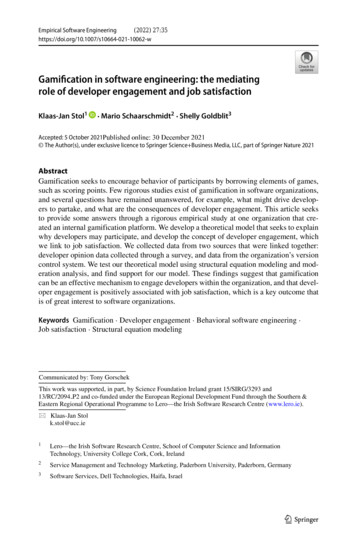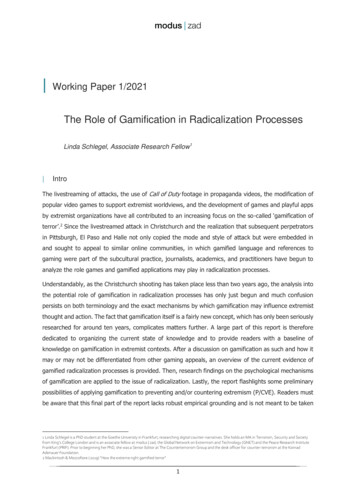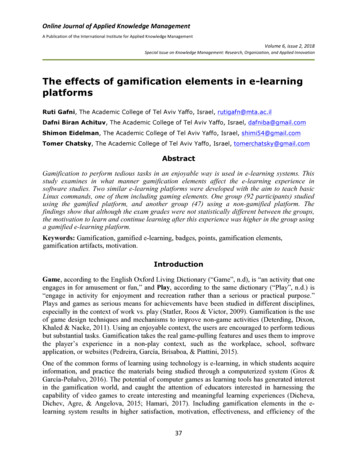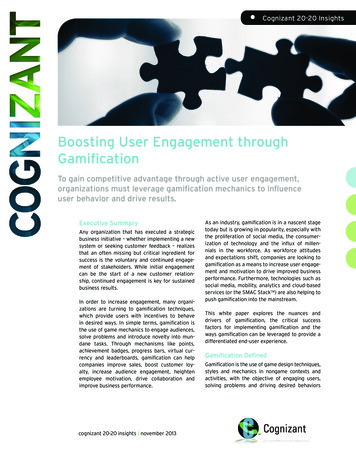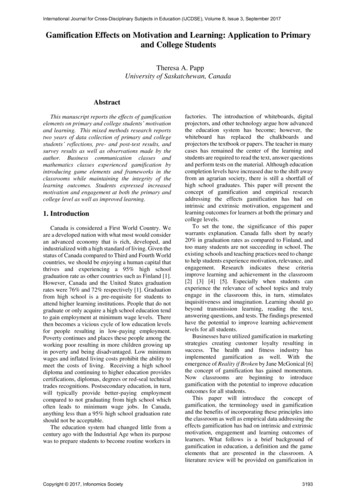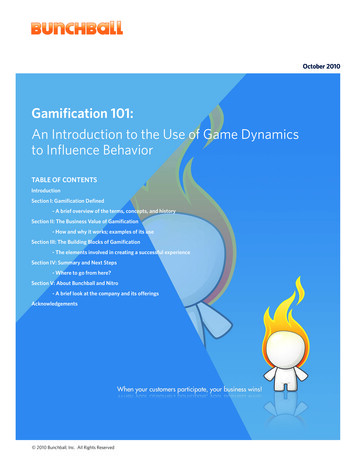
Transcription
October 2010Gamification 101:An Introduction to the Use of Game Dynamicsto Influence BehaviorTABLE OF CONTENTSIntroductionSection I: Gamification Defined- A brief overview of the terms, concepts, and historySection II: The Business Value of Gamification- How and why it works; examples of its useSection III: The Building Blocks of Gamification- The elements involved in creating a successful experienceSection IV: Summary and Next Steps- Where to go from here?Section V: About Bunchball and Nitro- A brief look at the company and its offeringsAcknowledgements 2010 Bunchball, Inc. All Rights Reserved
white paperGamification 101: An Introduction to the Use of Game Dynamics to Influence BehaviorGamification 101: An Introduction to the Use ofGame Dynamics to Influence Behaviorga mi fi ca tion [gay-muh-fi-kay-shuhn]I. GAMIFICATION DEFINEDintegrating game dynamics into your site,service, community, content or campaign,in order to drive participation.Definition of TermsWe’ll expand each of the following definitions in greater detail throughout the whitepaper. As an introduction, let’s give a brief overview of afew key terms that are central to this paper.INTRODUCTIONWhy Should You Care?GamificationAt its root, gamification applies the mechanics of gaming to nongame activities to change people’s behavior. When used in a businessGamification — applying the mechanics of gaming to nongame activi-context, gamification is the process of integrating game dynamics (andties to change people’s behavior — is an important and powerful newgame mechanics) into a website, business service, online community,strategy for influencing and motivating groups of people. The businesscontent portal, or marketing campaign in order to drive participationcommunity is just starting to realize the power it has to improve cus-and engagement.tomer engagement, build loyalty, and incent employees and partnersto perform at high levels. And the concept has the potential to solve avariety of problems outside the business world as well, in areas such as: Health & Wellness: healthcare cost containment, obesity programs,smoking cessation Education & Training: e-learning, corporate and vocational training,online testing Public Policy & Government: education reform, climate change,welfare reform Participation and EngagementThe overall goal of gamification is to engage people to participate — toshare and interact in some activity or community by offering a compelling, dynamic, and sustained gamification experience, and which can beused to accomplish a variety of business goals.Game Mechanics & Game DynamicsThese two terms are closely related and sometimes used interchangeably. For our purposes, game mechanics are the various actions,But beware of the hype! As with many new and promising technologies,behaviors, and control mechanisms that are used to “gamify” an activitythere are already a lot of pundits who have jumped on the gamification— the aspects that, taken together, create a compelling, engaging userbandwagon and hyperbole is flying. Simply Googling the word “gamifi-experience. The compelling, motivational nature of this experience is, incation” brings up articles and videos with titles like “Gaming Can Maketurn, the result of desires and motivations we call game dynamics.A Better World,” “The Gamification of Life,” and “The Gamification ofGame mechanics include:Game dynamics include: Points Reward Levels Status Challenges Achievement Virtual goods and spaces Self-expression Leaderboards Competition Gifts and charity AltruismEverything.”Understanding how and why gamification works, in what contexts it ismost effective, and what the limits are of this approach will be highlyuseful in sorting out the useful bits. This report will help provide a basicfoundation and definition for the concept of gamification. We plan toextend and build upon this foundation as we try to help move gamification from an art to a science. Please let us know what you think of thiswhitepaper by sending us an email at gamification101@bunchball.com. 2010 Bunchball, Inc. All Rights Reserved2
white paperGamification 101: An Introduction to the Use of Game Dynamics to Influence BehaviorGames Are EverywhereHumans have been playing games in various forms since the daysof the caveman, and competition is deeply ingrained in the humanStarbucks,” to earn special trophies or badges. The points aren’t worthanything, and the badges don’t get you anything — they’re just usingfun to get people to visit Starbucks.psyche. Fast forward to the modern era with the significant free timethat people have today, and gaming has become a hugely popularand tremendously profitable industry, on the order of 60 billion peryear. Given this wide acceptance of gaming and the emergence of theinternet, people have become more open to game mechanics in otherparts of their lives. As a result, “gamification” is becoming a powerful tool through which organizations teach, persuade, and motivatepeople. Many different activities that people do today incorporate gamemechanics – things that you might not think of as games at all. Let’sexamine a few.Frequent Flyer Programs120 million people around the world are accruing points, leveling up,and earning rewards in the Frequent Flyer Programs (FFPs) offeredby nearly every major airline. FFPs are actually complex games, withcustomers earning miles (points) for every segment flown, movingfrom Bronze to Silver and Gold status (leveling up), and even completing challenges like “Fly 3 segments in the next 90 days for 2500 bonusmiles.” And they’ll go out of their way to stick with the vendor wherethey have the most points and status — even when disappointed withthe actual service.Nike and the iPodThe world’s largest manufacturer of athletic footwear and apparelworldwide has “gamified” exercise with the launch of Nike in 2008.Over 1.8 million runners are currently using Nike to capture data suchas distance, pace, and calories burned using a GPS sensor connectedto their iPod. The Nike software loaded on the iPod will then ”reward“users if they reach a milestone — for example, runners hear Tour deFrance cycling champ Lance Armstrong congratulating them if theybeat their five-mile distance record. After workouts, runners go onlineto upload their data, track their statistics, set goals, join challenges, playwith an online “alter ego,” and connect with fellow runners in the Nikecommunity and other social networks. Nike has allowed the companyto build a huge and active fan base — for instance, over 800,000 runners logged on and signed up when Nike sponsored a 10K race simultaneously across 25 cities.Starbucks and FoursquareThe world’s biggest coffee chain is rewarding users with virtual pointsand virtual badges for visiting their retail stores. Starbucks, in conjunction with a startup called Foursquare, enables their customers to“check-in” at their retail locations on their mobile phones. And whenthey do, they earn points and can complete quests, like ”visit 5 different 2010 Bunchball, Inc. All Rights Reserved3
white paperGamification 101: An Introduction to the Use of Game Dynamics to Influence BehaviorParticipation and the IKEA EffectII. THE BUSINESS VALUE OF GAMIFICATION“Research conducted with my col-Participation Drives Business Valueleagues Daniel Mochon, of Yale Univer-Participation builds lasting relationships and impacts fundamental business objectives.sity, and Dan Ariely, of Duke University,shows that labor enhances affectionfor its results. When people constructproducts themselves, from bookshelvesto Build-a-Bears, they come to overvalue their (often poorly made) creations.We call this phenomenon the IKEAeffect, in honor of the wildly successfulSwedish manufacturer whose productstypically arrive with some assemblyrequired.”When people participate, it means that they’re engaged with you, that you’re buildinglasting relationships with them, and that you’re impacting your fundamental businessobjectives. If you can get people to participate, your business wins. But what kind ofparticipation? Gamification can drive virtually any kind of participation, including: Watching videos Listening to audio Viewing photos Reading articles Filling out registration data Opting in to email communication Creating content Answering questions Making a purchase Taking quizzes Searching for information Sharing personal info Rating products Voting on content Writing comments Participating in discussions Posting to forums Taking a poll Visiting repeatedly Visiting affiliated sites Recommending affiliated sites- Michael I. Norton, “The IKEA Effect:When Labor Leads to Love,” HarvardTracking Statistics Drives ParticipationBusiness Review – Breakthrough BusinessAt its core, gamification is all about statistics. If two people play Monopoly every dayIdeas for 2009,” February 2009.for a week, it’s going to get boring pretty quickly. But if they start capturing and displaying statistics — how many times each person won, how many dollars each winner had,which properties were most profitable — then the experience becomes more interesting.These statistics create another level to the game and motivate people to play more. Inessence, the statistics become the game. Can you become the #1 ranked Monopolyplayer in your group of friends, in the state, in the country? Can you own Boardwalkand Park Place five games in a row, and thus win a special trophy? Can you earn Monopoly Points for every dollar you end the game with, and collect those points towardsome ultimate reward?By capturing statistics, communicating standings, and rewarding accomplishments,we create a new method to drive participation. Even though individual games (or otheractivities) may have lost their initial excitement, each episode becomes an entry intoa larger game, one that creates a desire to make return visits in order to reach thesenew goals.StatusReward 2010 Bunchball, Inc. All Rights ReservedAchievementStatisticsCompetition4
white paperGamification 101: An Introduction to the Use of Game Dynamics to Influence BehaviorWho Is Participating?Gamification is a strategy for influencing and motivating the behavior of people – anypeople, whether they are customers, employees, students, fans, constituents, patients,etc. And while it uses techniques from game design, it is not a new way to reach thegamer market. The audience for gamification is anyone you want to engage repeatedlyin order to elicit a particular behavior.Use Cases of Gamification“Companies of all shapes and sizesThe following examples illustrate some of the applications in which gamification can behave begun to use games to revolution-used to create business value.ize the way they interact with customers and employees, becoming morecompetitive and more profitable as aresult.”- “Changing the Game”, David Edery,Ethan MollickBuilding and activating a community of members or fansA common business goal is to pull together and engage a group of people with a common passion or interest, and then to “activate” them to purchase. In particular, manymarketers have been looking to leverage online social networking for this purpose, butthe results have been mixed. Adam Sarner, an analyst with market research firm Gartner, has projected that over 75 percent of Fortune 1000 companies with Web sites willhave undertaken some kind of online social-networking initiative for marketingor customer relations purposes. But 50 percent of those campaigns will be classifiedas failures.1 And Forrester analyst Jeremiah Owyang concludes that “ manybrands are wasting their time, money, and resources to reach communities insocial networks without first understanding that the use case is very different thana microsite campaign.”2Through gamification, organizations can take back control of the brand experienceby engaging users, encouraging them to join a community, driving active participation,sharing with friends outside the community, and even recruiting friends tojoin the community. Gamification enables you to turn customers into fans, andfans into evangelists.1http://news.cnet.com/8301-13577 cial-network-marketing-2008/2 2010 Bunchball, Inc. All Rights Reserved5
white paperGamification 101: An Introduction to the Use of Game Dynamics to Influence BehaviorExample: Global Technology CompanyA leading computer manufacturer recently launched a campaign onFacebook to build up a community of college students focused around“tech stuff,” with the goal of promotion their educational computing siteand sell more student laptops. To drive the growth of this Facebook site,they created a gamified Facebook application that offered students achance to win a 5,000 scholarship and a free PC for a friend. In orderto win, students had to earn points and awards for doing things likeregistering for the contest, inviting a friend to join, creating a team, andregistering on the company’s educational computing site, and postingcontest messages and awards on their wall on Facebook. The result? Sixweeks after the launch of the gamified Facebook application, they hadincreased program participation 10X. Other success metrics from thecampaign: 1 in 6 participants wrote and submitted an essay(one of their missions) Almost 1 in 5 made the student laptop their profile picture onFacebook for a day (one of their missions)Example: Global Consumer ProductA European consumer and industrial products company made adecision to shift the marketing strategy for one of their top PersonalCare products to a “high engagement, online ecosystem” model. The 1 in 4 recruited their friends to help them (one of their missions)program that came out of this strategy was a social networking applica- 1 in 3 checked out the student laptop reviews (one of their missions)tion connecting participants across the web and social media. The goal 1 in 3 promoted the Facebook application (one of their missions)for participants is to earn rewards by completing challenges, such as 1 in 3 posted their award and new levelviewing a series of web pages or playing Flash mini-games on partner 1 in 3 visited the educational computing sitesites. The social game has been explicitly designed to encourage longterm engagement of participants, with repeat users earning frequentBuilding your brandrewards.In the long run, the goal of marketing is to maximize the lifetimeThe company created an initial core user base via co-branding with avalue of the customer base by increasing the average selling pricetop-tier North American professional sports league, and then grew theand frequency of purchase. The traditional way that marketers lookuser base using viral game mechanics that motivate participants toat this process is the “purchase funnel,” a model which describes theinvite friends from their social networks. Other game mechanics focustheoretical customer journey from the moment of first contact withon activating fans, friends, and all others with brand purchases and tri-your brand (awareness) through product consideration, to the ultimateals via promotional integration. A microsite serves as the participants’goal of a purchase. Using gamification, marketers can help increasedashboard, providing a central location to customize their avatar, viewbrand awareness, affinity, and purchase intent by driving their audiencetheir progress, accept challenges and engage in social activities. In addi-to spend more time on a website or related social media property andtion, the experience requires repeat visits to the microsite, strengthen-come back more often. The more users interact with a site, the moreing the participant’s association with the brand.valuable and loyal they become and the less incentive they have to clickaway to another source. 2010 Bunchball, Inc. All Rights Reserved6
white paperGamification 101: An Introduction to the Use of Game Dynamics to Influence BehaviorDriving engagement and loyaltyExample: Major Entertainment CompanyLoyalty has evolved beyond earning points for purchases to deeper cus-One of the largest entertainment companies in the world wanted atomer engagement. Traditional redemption-focused loyalty programsloyalty system that not only rewarded purchases, but also rewardedcreated clever points systems and offered gifts or discounts in returnparticipation and engagement with their content, which includes majorfor purchases. These marketers assumed that the best consumers willmotion pictures. This program gave points for purchasing Blu-ray and“burn” what they’ve earned, be satisfied with the reward, and comeregular DVDs as well as movie tickets. Buyers then redeemed thoseback to the brand in the future. Savvy marketers now realize that theypoints for dollar-value products, like more DVDs. In addition, membersmust differentiate themselves from this foundational model, primar-can earn credits for engaging with their content, like watching movieily because the rewards given by most loyalty programs offer far lesstrailers, visiting movie websites, playing games, and contributing con-competitive advantage in the age of the internet and global commerce.tent. By combining offline purchase data with online engagement andUsing gamification, loyalty programs can significantly increase theirparticipation data, they can now build a detailed profile of each of theireffectiveness by adding more intrinsic motivators to the “earn” (points)customers. The resulting gamification campaign has:aspect of the loyalty experience. Increased consumption of promotional contentEarning points mimics the elements of a game, including competition Increased user-generated contentand the pursuit of a goal. Fun, compelling and addictive game play gen- Increased traffic to the individual movie siteserates exciting emotions that add to the player’s experience, whether Increased sale of productsthe competition is solitary or involves others. An effective loyalty Developed a 360-degree view of their customers.program views the entire “earn” experience as a game, one wherein the“play” is just as fun as the “winning.” Adding leaderboards and tieredachievement levels will enhance the gaming aspects because peopleoften desire the challenge of working for a reward. Essentially, the rightlevel of challenge arouses and excites the brain. Setting and hittingmilestones result in a repeated sense of accomplishment and boostsself-worth, leading to the ultimate satisfaction of reaching the goal and“winning the game.”3YearnLoyaltyProgramsEarn3BurnBarry Kirk. “A New Paradigm for Loyalty Marketing,” Maritz White Paper, August 2010 , http://www.maritz.com/ ew-Paradigm-Loyalty-Marketing.ashx 2010 Bunchball, Inc. All Rights Reserved7
white paperGamification 101: An Introduction to the Use of Game Dynamics to Influence BehaviorMotivating behaviorWherever there are people, there are people to be motivated. Sales people and channel partners can be incented to grow revenuesand focus on desired product mixes via competition and challenges. Call centers and customer support organizations can be motivated todeliver superior customer service through a customer feedbackmechanism or other metrics. Employees can be motivated to pursue optional training initiativesthat enhance their careers and make them more valuable to thecompany. Patients and health insurance customers can be incented to adopt andstick with healthy lifestyle choices that extend their lives and reducehealthcare costs.Gamification can be applied across a broad spectrum of situationswhere individuals need to be motivated or incented to pursue specificactions or activities.Example: HopeLabHopeLab is an innovative organization whose mission is to drivepositive health behavior in young people. Fighting chronic illnesseslike cancer, obesity, and depression, HopeLab uses games and connected devices to create the most effective motivational methods.For example, the Zamzee device is worn on a belt or carried in a pocket,and it monitors physical activity throughout the day. Plugging it intoa computer, this data is converted to points that can be redeemed forvirtual goods and real-world rewards, including the ability to donate toa cause. Though the product is still under development, a pilot studyshowed that kids using the Zamzee device and website were about30% more active than those who did not. 2010 Bunchball, Inc. All Rights Reserved8
white paperGamification 101: An Introduction to the Use of Game Dynamics to Influence BehaviorIII. THE BUILDING BLOCKS OF GAMIFICATIONTo repeat our definitions from the beginning:Gamification drives participation and engagement by integrating gameexperience around existing website functionality or content. Some ofthe most common game mechanics include the following:Pointsmechanics or game dynamics into a website, business service, onlinePeople love points. They love to earn them and tocommunity, content portal, or marketing campaign. Gamification isachieve them. This makes points incredible motiva-an emerging marketing discipline that provides a means of influencingtors. Points can be used to reward users across multiplethe behavior of people online. It borrows key concepts from a numberdimensions, and different categories of points can beof related areas, including game design, customer loyalty programs,used to drive different behaviors within the same site or application.behavioral economics, and community management.Points can also be used as status indicators, users can spend them toGame mechanics are the rules and rewards that that make up gameplay — the aspects that make it challenging, fun, satisfying, or whateverother emotion the game’s designers hope to evoke. These emotions, inturn, are the result of desires and motivations we call game dynamics.Game Mechanics Motivate Behaviorsunlock access to content, or spend them on virtual goods and gifting.Studies done at IBM Research and the University of Chicago describethe dramatic effect that earning points can have on user behavior, evenif there’s no monetary value associated with them. People just love tobe rewarded and feel like they’ve gained somethingLevelsThe addition of game mechanics to a site or application allows you toLevels are different classes in frequent-flyer programs,layer compelling user experiences into existing activities. These gami-colored belts in martial arts, job titles in industry: anfied activities satisfy basic human desires, creating the addictive userindication that you’ve reached a milestone, a level ofexperiences that motivate users to take certain actions. But what arethese game mechanics?accomplishment in a community and should be affordeda certain amount of respect and status. Levels are often defined asGame mechanics are tools, techniques, and widgets that are used asbuilding blocks for gamifying a website or application. Using themindividually or together, it’s possible to build a highly motivational userpoint thresholds, so that users can automatically level up based ontheir participation, or use levels to indicate status and control access tocontent on the site.Figure 1 illustrates the interaction of basic human desires and game play. The green dots signify theprimary desire a particular game mechanic fulfills, and the blue dots show the other areas that it affects. 2010 Bunchball, Inc. All Rights Reserved9
white paperGamification 101: An Introduction to the Use of Game Dynamics to Influence BehaviorChallenges, Trophies, Badges, AchievementsCompetitionsChallenges (aka trophies, badges, or achievements) giveCompetitions enable your users to challenge each otherpeople missions to accomplish and then reward them forto get the high score at some activity. Once everyonedoing so. Challenges give people goals and the feelinghas done the activity, the user with the highest scorelike they’re working toward something. The general ap-wins a reward while all the losers get a consolation prize.proach is to configure challenges based on actions that you’re tracking,This is great for “multiplayer-enabling” one-player games and otherand reward your users for reaching milestones with trophies, badgessingle user experiences. For example: “I just scored 500,000 points atand achievements.Asteroids, I dare you to beat that!”Trophies, badges, ribbons, etc. are the visible recognition of havingreached new levels or completed challenges. One of the keys to makingGame Dynamics Satisfy Desireslevels and challenges effective is providing a forum for them to show offWhy are people motivated by game mechanics? Because of gametheir achievements, like a trophy case or user profile page that displaysdynamics.their badges. These have counterparts in the real world as well, as inScouting merit badges, colored credit cards that indicate high spendinglimits, or colored frequent flyer cards that indicate member status.People have fundamental needs and desires — desire for reward, status,achievement, self-expression, competition, and altruism among others. These needs are universal, and cross generations, demographics,cultures, and genders. Game designers have known for years how toVirtual GoodsVirtual goods are non-physical objects that are purchased for use in online communities or online games.They have no intrinsic value and, by definition, areintangible. Virtual goods include such things as swords,coins, and potions, as well as digital gifts and digital clothing for avatarsand virtual rooms. Virtual goods give your users a place to spend theirpoints, a reason to want to earn, a way to buy each other gifts, and away to self-express. Virtual goods can also be used as a revenue center,by selling users virtual goods for real dollars.address these needs within gaming environments, and gamificationnow enables these precepts to be applied more broadly. By wrappingthe appropriate set of game mechanics around your website, application, or community, you can create an experience that drives behaviorby satisfying one or more of these human needs:RewardHuman beings are motivated by receiving rewards — something ofvalue given for some kind of action. A reward, tangible or intangible,is presented after the occurrence of an action (i.e., behavior) with theFor a game economy to be effective over time, it helps to have a placeintent to cause the behavior to occur again. With gamification, theto spend your points, a reason to want to earn more, and the ability toprimary reward mechanism is through earning points or the equivalentcustomize something that reflects your identity. Because that gets you(like frequent-flyer miles). But obtaining virtual goods, leveling up, andinvested, it gets you locked in, and it becomes a really great vector foreven completing achievements also satisfy this desire.creativity, competition, and self-expression in the community. You wantyour wall or virtual environment or avatar to look good, because all yourfriends can see it and compare it to theirs.StatusHumans generally have a need for the esteem and respect of others,for status, recognition, fame, prestige, and attention. Status and esteemLeaderboardspresents the normal human desire to be accepted and valued by othMost of the successful games ever created have wiselyers. People need to engage themselves to gain recognition, and haveimplemented a “high-score table.” They bring aspira-an activity or activities that give them a sense of contribution, to feeltion, “fame,” and your name in lights. They also indicateaccepted and self-valued. All elements of game mechanics drive the“how am I doing” against friends and against everybodystatus dynamic, but having achieved a higher level (such as getting aelse. In the context of gamification, leaderboards are used to track andgold or platinum credit card) is the primary motivator.display desired actions, using competition to drive valuable behavior. 2010 Bunchball, Inc. All Rights Reserved10
white paperGamification 101: An Introduction to the Use of Game Dynamics to Influence BehaviorAchievementCompetitionSome (but not all) people are motivated by a need to achieve, to ac-Individuals can also be motivated by competition. It has been provencomplish something difficult through prolonged and repeated efforts, tothat higher levels of performance can be achieved when a competitivework towards goals, and to win. People motivated by achievement tendenvironment is established and the winner rewarded. That’s becauseto seek out challenges and set moderately difficult (but achievable)we gain a certain amount of satisfaction by comparing our performancegoals. Their most satisfying reward is the recognition of their achieve-to that of others.ments.Self-expressionMany people want and need opportunities to express their autonomyand originality, to mark themselves as having unique personalities fromthose around them. This ties into the human desire to show off a senseof style, identity, and personality and to show off an affiliation with agroup, or demonstrate a connection with a celebrity of some kind. Usingvirtual goods is a common way for players to create their own identity,whether they are earned through rewards, received as gifts, or boughtdirectly with real currency. A person’s avatar can often serve as a richfocal point for expression, and some people update their Facebookprofile picture more than once a day.All elements of game mechanics tap into this desire, even selfexpression, but the use of leaderboards is central to display competitive results and celebrate winners. Most all games provide at least asimple top ten list, and using that public display to indicate new levelsachieved, rewards earned, or challenges met can be a great motivatorto other players.AltruismGift-giving is a strong motivator if you have a community where peopleseek to foster
join the community. Gamification enables you to turn customers into fans, and fans into evangelists. white paper Gamification 101: An Introduction to the Use of Game Dynamics to Influence Behavior “Companies of all shapes and sizes have begun to use games to revolution-ize the way t

